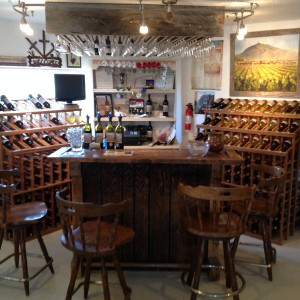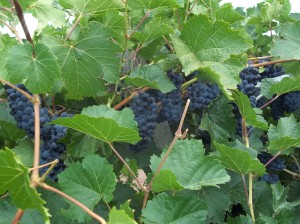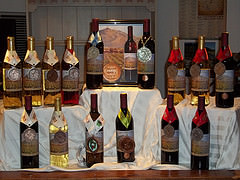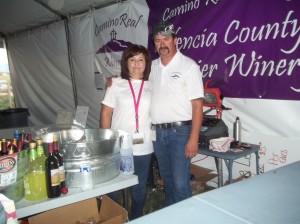From the Valencia County News Bulletin Written by a Staff Member
As the sun begins to set, the storm clouds to the north of Tome Hill are thrown into sharp relief. White streamers reach towards the ground and appear to be forming a funnel cloud. Santos Griego and Jonathan Chavez eye the clouds, and potential disaster, with trepidation, remembering the destruction of last August.
When a late summer hail storm ripped through the southern part of the valley last year, Griego and Chavez were left with nothing but shredded grape vines and pulped fruit.
“There wasn’t anything left,” Griego said. “We didn’t get to harvest anything.”
But this year has gone much better. Last weekend, with friends and family in tow, they filled bucket after bucket with juicy bunches of dark purple grapes.
The fruit was then taken to Griego’s home, just three miles south of the field on Chavez’s property, where it was pressed and the juice put into 20-gallon fermenting tanks. Now the two wine growers get to play the waiting game.
While the two vats of white wine, sprinkled liberally with oak chips for a distinct flavor, will be ready to drink by Christmas, most likely, Griego says, the red can take years to reach full maturity. Wine making is a slow process, one that requires patience and dedication, the two men say.
“The fruit we harvested this year is from vines we planted three years ago,” Griego said. “So it’s a three year minimum before you see any returns.”
After being introduced to the process of harvesting and making wine nearly eight years, Griego and Chavez were both bitten by the bug and decided to try their hands at the thousand-years-old craft.
Right now, their enterprise, Camino Real Winery, is small in volume, but the physical operation runs from Tomé to south of Belen. The smaller, experimental vineyard is at Chavez’s home. The fermentation vats, and other processing equipment, is kept in Griego’s climate-controlled garage, and just off N.M. 47 is four acres of grapes owned by Henry Jaramillo, long-time wine grower and maker in the valley.
The three men have partnered with an effort to bring the wine making culture back to Valencia County once again.
“The micro-climate here is perfect for this,” Griego said.
Jaramillo, who has grown grapes on the sandy llano above the river for 26 years, agrees.
“Grapes ― they don’t like a lot of standing water around their roots,” Jaramillo said. “Around the turn of the century, there was a lot of flooding here, and it wiped out most of the vineyards.”
Not only is growing the grapes and making the wine a fairly time-intensive process, so is getting the right licensing from the state. Right now, Griego and Chavez can produce up to 200 gallons of wine a year for personal use, and to give to friends and family.
“It makes a great Christmas present, but we can’t sell any of it right now,” Griego said.
The winery has applied for what is known as a master wine growers’ license from the state and is awaiting the final decision. In the meantime, they have been given a conditional use permit by the county’s planning and zoning board to grow the fruit at Chavez’s property.
“This is the first step,” Griego said. “We need to get our license from the state, and ultimately we want to look for the ideal location to grow more plants and have a fully operational winery with a tasting room.”
And what they build won’t be typical. Wanting to combine the past with the present, the initial plans call for a mission-style building made from adobe combined with the latest in photo voltaic technology for power.
“What I would like to do is use water to cool the fermenting tanks,” Griego says. “We could draw the water up, run it through coils of pipe around the tanks and then send it back down into the aquifer.”
Combining that with a few windmills to take advantage of New Mexico’s nearly eternal wind, all they will have to leave for is potato chips, Griego declares.
“And we can probably make those ourselves too,” he laughs.
The business partners also want to get the community involved in the project as well. In October, Griego and Chavez plan to hold a day-long wine seminar to pass along all of the things they have learned to anyone interested in growing grapes for wine.
“I would love to see vines in every yard up and down (Highway) 47,” Griego said. “You can put in as many, or as few, as you want.”
They estimate five good producing vines will make five gallons of wine.
Chavez noted that there is assistance available to growers to pay for the installation of the efficient drip irrigation systems for the vines.
“There are subsidies available because you’re using less water,” he said.
But he does make the point that this business is not for the faint of heart.
“You have to plant them. Then there’s watering, fertilizing, keeping pests away,” Chavez said.
“Then there is the harvesting, pressing and fermenting. It’s a lot of blood, sweat and tears.”
The end result is definitely worth all the work, Griego says.
“There is nothing like sitting down at the end of the day on the front porch with the dog and with a perfectly chilled glass in your hand,” he said.
“This all comes from love. You can taste the difference when someone has been out toiling in the soil and making this with their own hands.”
The post Wine making in the heart of the Rio Grande Valley appeared first on Camino Real Winery.
]]>




